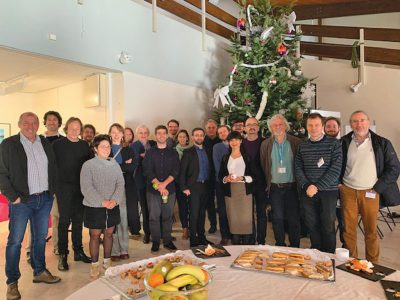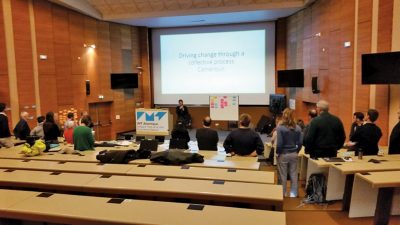Summary of a workshop on Marine Debris Indicators held in Brest in Dec 2019
May 26, 2020
by René Garello, IEEE Fellow
(This article was originally published in the OES BEACON and is reproduced here. It is part of Earthzine's Plastics themed articles for 2020)
THE WORKSHOP
The workshop on “Marine Debris Indicators: What is Next?” was held on December 16-18, 2019, in Brest, France. Building on a first workshop held in November 2018, also in Brest, on "Technologies for Observing and Monitoring Plastics in the Oceans,” this second workshop aimed to strengthen the link between observation, extracted information, and decision and policy making. The workshop also provided a platform for the further development of a community focusing on the monitoring and measuring of marine debris.
More information is available at: www.gstss.org/2019_Brest/index.php
Recognizing the UN targets for ocean plastic and related indicators, the second Marine Litter workshop brought together experts on observations and monitoring of marine debris and plastics with decision and policy makers in need of comprehensive information on this challenge. Focusing on targets and performance indicators, the goal was to converge towards common best practices and potential standards. Bringing in relevant stakeholders, the workshop also fostered collaborative networks to ensure that evidence-based decisions and policy-making are possible.
WORKSHOP BACKGROUND, OBJECTIVES, AND SCOPE
The Challenge
Marine debris is of growing global concern. Increasing material consumption and plastic production contribute to more marine litter and have resulted in estimates that over 8 million tonnes of plastic leak into the ocean each year. While quantitative information on production and use of plastics is to a large extent available, the fate of plastics discarded or leaked into the environment is highly uncertain. In particular, knowledge of how much plastic at different scales, down to micro and nano levels, reaches the ocean and the trajectories of the plastic in the ocean remain poorly known.

The Earth observation community so far has not managed to establish a global tracking and information system that would provide quantitative information on where and how plastics move in the ocean and allow the identification of the points where marine plastic pollution could be reduced most effectively. A necessary first step in addressing marine litter includes establishing a knowledge base for the amount of marine litter that has entered the ocean. In order to establish this knowledge base, the right actors need to be involved and they require a global platform to coordinate monitoring marine litter and informing action.
Pre-Workshop Activities
The goal of the November 2018 workshop on “Technologies for Observing and Monitoring Plastics in the Oceans” was to identify future technology initiatives able to address the mounting global marine debris with particular focus on plastics in the ocean. The workshop addressed the interest of the UN Environment Program in finding support for their efforts to develop the methodology for monitoring marine debris indicators, in particular the Indicator 14.1.1 “Index of coastal eutrophication and floating plastic debris density” of the Sustainable Development Goal (SDG) 14 “Conserve and sustainably use the oceans, seas and marine resources for sustainable development.” The major outcome of this workshop was a draft road map with a set of activities and goals for six months, two years and 5 years, which provided an initial road map (see R. Garello et al., “Technologies for Observing and Monitoring Plastics in the Oceans”, IEEE/MTE OCAENS 2019, June 2019)
At a Town Hall meeting at the OCEANS 2019 conference in Seattle on October 29, 2019, the challenge of marine debris, in particular plastics, was presented and approaches to monitoring indicators were considered. The discussion touched upon a wide range of topics including the societal challenge of reducing the use of plastics in an economy that has developed a high dependency on plastics, detecting and monitoring plastics in the environment and in the oceans, understanding the impacts of plastics on the biosphere including humans, and approaches to a better linking of science and policy making.

Both events provided valuable input for working out the scope and objectives of the second workshop program and the development of the program.
Workshop Scope and Objectives
Building on the recommendations and draft road map of the 2018 Workshop, the main goals for the workshop were to further develop a community of stakeholders around marine debris and to further detail the road map towards a joint goal. The overarching goal for this community is to achieve a comprehensive description of observation means (underwater, satellite-borne, in situ, crowd sourcing, Big Data analyses) and assess their technological readiness, as well as their availability for relevant indicators, including the SDG Indicator 14.1.1, and to ensure that a range of emerging efforts to address the global challenge of marine debris can be based on sufficient observational evidence.
The workshop explored the potential for a platform linking the data to actions and develop an implementation strategy for observing networks and modeling platforms to support co-creation of knowledge needed by those addressing all aspects of marine debris.
PARTICIPATION
The workshop brought together a broad range of stakeholders from Earth observation communities, research communities assessing the intermediate and long-term impacts of marine debris, United Nations and national agencies engaged in making progress towards SDG 14, businesses tackling various aspects of the problem of marine debris, as well as experts working at the interfaces between these communities with the goal to ensure that knowledge required for policy making is created, accessible and usable.
More than 50 in-person and remote participants from twelve countries represented a wide range of stakeholders from all societal sectors.
WORKSHOP APPROACH AND FORMAT
The first part of the workshop included several sessions with invited presentations and brief discussions. This part aimed at reviewing the current state in monitoring marine debris and relevant modeling, and aimed at an overview of the knowledge needs for societal decision making on mitigating the threat marine debris poses to the ocean and human beings. (See the next section for more details.)
The second part took a participatory approach in which the participants worked together to improve the draft road map that resulted from the first workshop in 2018. Initially, several groups collected sets of relevant terms and developed graphics of their vision for the next five years. Then the plenary agreed on a common vision, which provided a basis for the work on elements of the road map with a particular focus on the elements to be implemented during the six months leading up to the next workshop in June 2020 in Lisbon, Portugal. During the final session, input for a case study on “Reducing Plastics in the Ocean within a Growing Global Economy: Understanding the Information Needs to Support Interventions” was collected in a participatory effort.
WORKSHOP PROGRAM AND CONCLUSIONS
The workshop was divided into sessions dispatched all along the 4 half-days of the meeting:
Session 1: Speed Meeting
Session 2: State of the Art and Emerging
Session 3: Monitoring: From Sensors to Indicators and Policy
Session 4: Observations and Models for Marine Debris Indicators
Session 5: Posters
Session 6: Connecting Data to Actions
Session 7: Road Map
Session 8: Working Groups – Road Map
Session 9: Wrap Up – Conclusions
Preliminary outcomes
A representative of the DG Research & Innovation, Directorate C Healthy Planet, was an invited speaker and discussed the EU policy and actions on reducing marine litters, including plastic debris, and he emphasized that there are many relevant policies and initiatives, including among others the efforts to make progress towards a circular economy. With respect to plastics, the “European Strategy for Plastics in a Circular Economy” provides focused international actions, aims to improve reuse and recycling, as well as curbing marine litter, and promotes investigations of circular solutions. He outlined many funding opportunities and pilot actions for the removal of marine litter. Importantly, there is an ongoing effort to achieve a common European framework that harmonizes procedures for plastic pollution monitoring. The participants worked collaboratively on the further development of a road map. And the main focus was on the next six months, with a plan for actions to be developed prior to the third workshop to be held in June 2020 in Lisbon, Portugal, at the “United Nations Decade of Ocean Science for Sustainable Development first meeting,” the “2020 UN OCEAN CONFERENCE”).
- Community building and organization:
- How to benefit from it?
- Identify and connect scientific communities;
- Finance:
- Donors funding;
- Budgeting;
- A project to commit time.
- Strategy:
- Scoping of targets;
- Connecting knowledge and action.
- External stakeholders:
- Identify stakeholders;
- Synergies;
- Understand stakeholder needs.
- Content:
- Monitoring;
- Mitigation;
- Value added;
- Problem identification;
One session was devoted to a further development of the draft road map. A first step in this process is to agree on a common goal. For that, four groups were asked each to develop a graphical vision for 2025. The groups presented their visions to the plenary and an open voting was used to determine the vision with the largest support.




